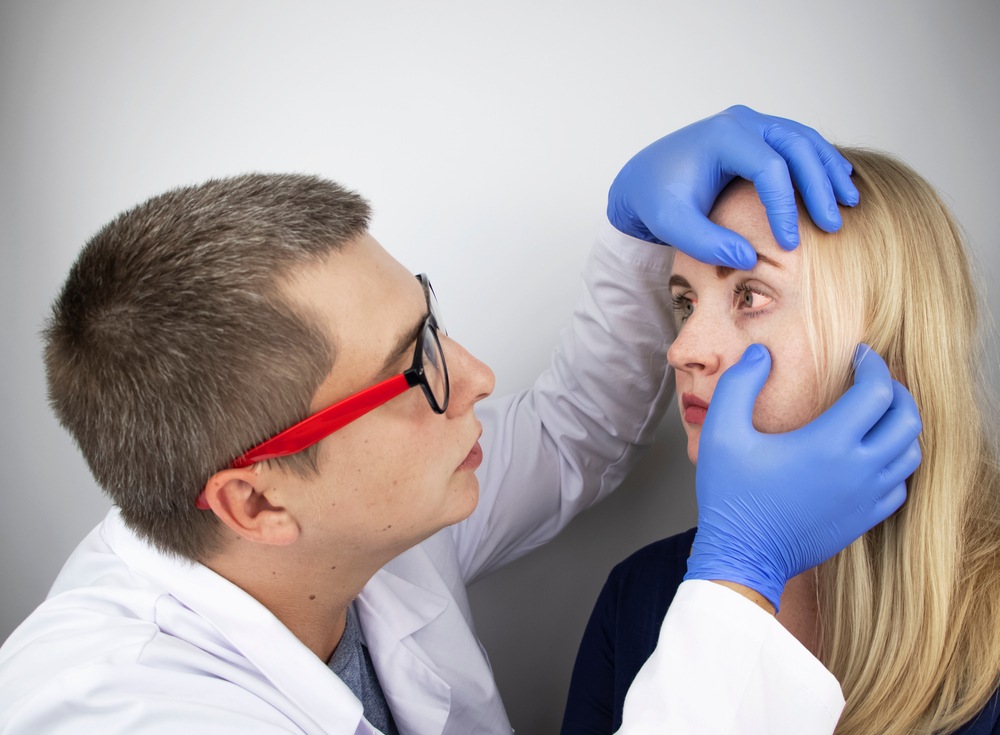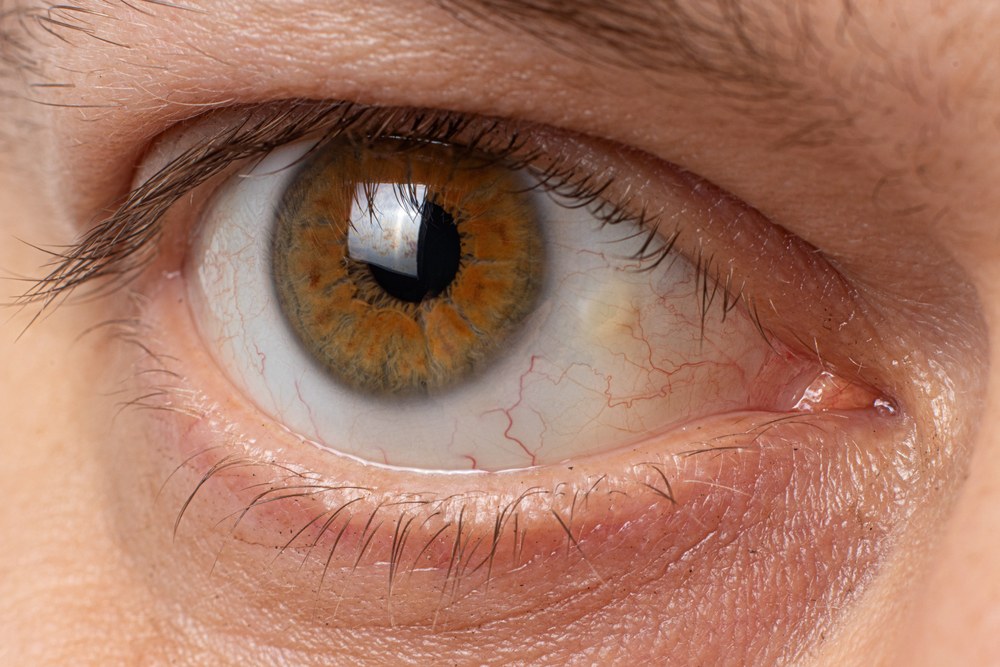Whether it’s a slight irritation or something else, red eyes can be the result of several concerning conditions. If you’re facing red eyes, you should always consult with an experienced eye doctor. For now, read on to learn if you should be concerned about your red eyes, what causes red eyes, and how to get rid of them.
Why Do Eyes Get Red?
The surface of the eye is covered in blood vessels that expand when irritated. This inflammation can come from infection, allergies, or strain. Once those blood vessels are irritated, they swell, giving the eye a red appearance. Red eyes are usually paired with symptoms like:
- Itching
- Pain
- Discharge
- Swelling
- Blurry vision
- And more
Red eyes can go away on their own at times with a little rest and separation from the cause of irritation. However, in other cases, red eyes can be a symptom of something more serious.
What Causes Red Eyes?
Red eyes can result in a variety of cases, from wearing contact lenses too long to allergies and chronic dry eyes. Sometimes, red eyes are the result of trauma or an eye infection. The causes of red eye often include:
Allergies
Dander from your fluffy cat could be what causes your red eyes. It could also be caused by dust, pollen, or even some foods. Allergies trigger the production of histamines, which can cause red, itchy, and watering eyes.
Pink Eye
Conjunctivitis, or pink eye, causes the epithelial tissue that covers the eye to swell, giving the whites of the eyes a pink look. Conjunctivitis can also cause the eyes to have a sticky discharge. Pink eye has bacterial and viral forms, and treatments will depend on the type of conjunctivitis diagnosed.
Chronic Dry Eyes
Comfortable eyes are lubricated. When the eye doesn’t produce enough tears to stay hydrated, it can become painfully dry, irritated, and red. Chronic dry eye symptoms including burning and pain can be treated with medications. Women in menopause and perimenopause may be prone to experiencing dry eyes. Treatment can be as simple as using over-the-counter or prescription medication.
Map-Dot Fingerprint Dystrophy
As the most common type of corneal dystrophy, this condition occurs when the epithelial tissue covering the cornea sloughs off, leading to corneal erosion and blurred vision. Since that can expose nerve endings, the eye can become red and painful. Flare-ups are resolved faster with medical care, but they can also resolve on their own.
Glaucoma
A condition that threatens vision, glaucoma has few initial symptoms. Symptoms like suddenly painful red eyes accompanied by nausea, vision loss, or seeing halos around lights indicate a need for urgent medical attention to preserve sight. A doctor should follow patients with glaucoma cases for treatment and monitoring for signs of disease progression.
Inflamed Eyelids
Blepharitis causes the eyelid to become inflamed and the eye to look red and feel itchy. Styes and excessive tears can be uncomfortable and irritating symptoms of inflamed eyelids. Doctors can treat this condition to soothe inflammation.
Trauma
When the eye is scratched or injured, the blood vessels will dilate to increase blood flow to the eye which will speed its healing. Eye injuries can include puncture wounds, chemical burns, and abrasions. Eye trauma requires urgent medical attention since injuries can become infected and lead to severe eye problems.
Smoking and Drinking
The old jokes about late nights out on the town leading to red eyes the next morning are based on fact. Smoking and excessive drinking can both be causes of red eyes. Rest and time away from smoke and alcohol will return eyes to normal.
Eye Strain and Late Nights
For example, college students studying all night for their exams may experience red eyes due to eye strain and late hours. Rest is good for your eyes and a solid night’s sleep will make eye inflammation go away.
How to Get Rid of Red Eyes
At Art of Optiks, our eye care specialists can treat minor cases of red eyes with medications including:
- Artificial tears: In cases of chronic dry eyes, artificial tears can keep the eyes moisturized, easing irritation and redness.
- Decongestant medications: Tetrahydrozoline and naphazoline constrict the blood vessels of the eye, making them less red.
- Antihistamines: For allergy sufferers, antihistamines can lessen allergy symptoms including itchy, burning eyes. These are available in prescription strength as well as over-the-counter versions.
- Dry eye management: treating the source whether it be the eyelids or tear production, will reduce redness. Cyclosporine, punctal plugs, lid hygiene and compresses may be helpful.
- Other options: Minor cases of red eyes may resolve themselves as soon as you are away from the allergy source, get a good night’s sleep, or shut your eyes to give them a rest. Cool compresses can also ease eye pain and redness.
When Should Red Eyes Grant a Visit to the Doctor?

Red eyes on their own may not be a reason to seek urgent eye care since many times, red eye symptoms will go away on their own. Aside from informing yourself on how to get rid of red eyes, you should seek urgent eye care services if you are experiencing these serious eye symptoms.
Sharp Pain
Don’t ignore severe eye pain since it can be a symptom of sight-threatening conditions such as glaucoma, a corneal ulcer, or keratitis.
Colored Halos
If the cornea grows thicker, vision will become cloudy and will scatter light, creating colored halos around lights. Seeing these halos with flashes and floaters can be symptoms of eye diseases that can harm vision.
Blurred Vision
Red eyes with blurry vision can be a symptom of vision-threatening eye conditions. Our ophthalmologists will perform an eye exam to detect whether you have an ocular disease or simply need vision correction.
Extreme Sensitivity to Light
Severe sensitivity to light, or photophobia, can indicate iritis, an inflammatory eye disease that can be debilitating if eye care is not received promptly.
Red Eyes in a Nutshell
Sometimes red eyes are simply a sign of tired eyes, allergies, or irritation, but not always. What causes red eyes could be a severe eye condition that could threaten your vision.
If experiencing red eyes with sharp pain, extreme sensitivity to light, blurred vision, or halos around lights, come see us immediately. Eye trauma or infection also requires urgent attention to prevent serious, long-term vision problems later.
Our highly trained doctors and staff members provide each patient with the best care. Education about eye care and conditions is part of the Art of Optiks experience, so our patients understand their treatments and how to get rid of and avoid red eyes in the future.
Our team will use the most up-to-date diagnostic techniques to determine what’s causing your red eyes and how best to treat your condition.
White Eyes Near the Horizon

Whether your red eyes result from eye strain and the need for vision correction, allergies, eye trauma or an ophthalmic condition, our eye doctors can quickly and accurately determine the best treatment for you and your eyes. Don’t delay getting urgent eye care. If your eyes are red, itchy, and painful, For the optimal optical experience, contact Art of Optiks today.

